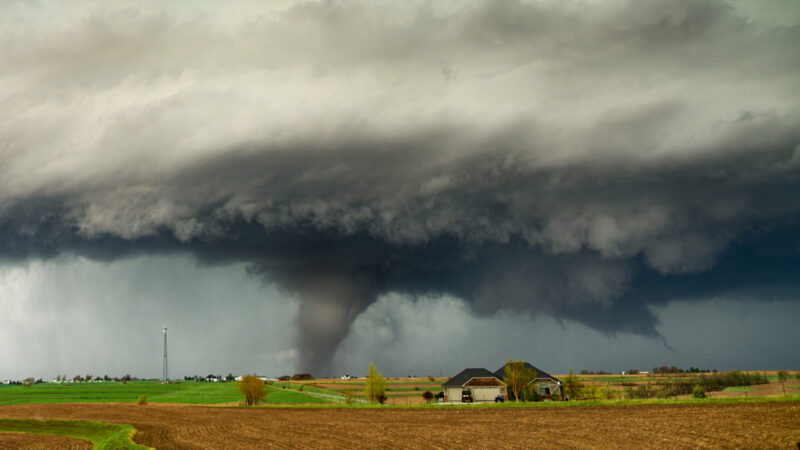Why this winter could bring more tornadoes to Alabama
Scientists are finding the tornado map of the United States is changing. In recent years, the Tornado Alley of the Great Plains has twisted into the southeast, a region known as Dixie Alley. Meanwhile, researchers are trying to develop forecast systems that give residents more warning time as Dixie Alley’s winter tornado season approaches.
Dixie Alley encompasses several southeastern states, including Louisiana, Mississippi, and Alabama. Harold Brooks, a senior research scientist at the National Oceanic and Atmospheric Administration National Severe Storms Laboratory, is one of the scientists keeping an eye on these storms. He researches where and when severe weather happens, how it will impact nearby communities and how forecasts are made to begin with. Brooks said tornadoes behave differently in the South than in traditional Tornado Alley. They’re smaller and more frequent.
“This is a place that concerns us,” Brooks said. “The Southeast in the winter time has the potential for really big weather events to occur and have devastating consequences.”
It’s a mystery that the Deep South is seeing more tornadoes. The same thing happened in the 1920s, but the historical record is too spotty to know exactly why. But Brooks does know that in the winter, starting in November through February, tornadoes become much more common in Dixie Alley. Brooks added that warmer temperatures across this region this year indicate there may be more tornadoes than usual. This is no guarantee, but residents should still be ready.
“It’s just like hurricanes,” Brooks said. “It doesn’t matter whether it’s a big year or a little year. If you happen to be impacted by one, it’s the biggest year of your life.”
Scientists are observing a higher frequency of tornadoes on any one given day than they have in the past.
“If we look at the average number of tornadoes across the country during the year, that’s actually stayed the same,” Brooks said. “But what we have now are actually fewer days per year that have one tornado.”
Tornadoes in Dixie Alley are more likely to be nocturnal in the winter , since there are more hours of darkness. These storms are harder to track and avoid. While Dixie Alley’s storms tend to be much smaller than those in Tornado Alley, Brooks says this only makes it harder to get people to take tornado warnings seriously.
“It’s hard to actually get public attention in the same way we can here in Oklahoma,” Brooks said, of Dixie Alley.
When clouds darken the horizon in Alabama, Brooks said residents might expect a thunderstorm rather than a tornado. This is dangerous since they typically only have 10 to 15 minutes to get out of the path of the storm. But that short warning time is what people like Patrick Burke want to change.
Burke is the program lead for the Warn-on-Forecast project at the National Severe Storms Lab. Burke said NOAA first started working on the Warn-on-Forecast system about 20 years ago. The goal was to change the severe storm forecasting game and make these storms much more predictable.
Today, forecasters usually rely on radar to find where a storm is happening and how strong it will be. Trained spotters send in reports to support that radar data.
“What we needed to do with Warn-on-Forecast is put those developing thunderstorms into a numerical model so that we can see out farther in time,” Burke said.
The Warn-on-Forecast system uses radar and satellite data, gathered every 15 minutes, and runs it through 18 different models. The more the information produced by each model agrees with the others, the more reliable the forecast. Burke said the system produces a new weather prediction every 30 minutes.
“We wanted to design a model system that specifically gets down to the question of which storm is going to produce the big tornado today and what communities will be in the path of that,” Burke said.
Burke said the Warn-on-Forecast system is still in its testing phase and is not yet ready for forecaster use on a day-to-day basis. Scientists are still trying to make that firehose of information more digestible. When it is ready, Burke said forecasters will be able to make a huge difference for people in the path of a tornado by giving them anywhere from an hour to three hours of warning time.
How Alabama Power kept bills up and opposition out to become one of the most powerful utilities in the country
In one of the poorest states in America, the local utility earns massive profits producing dirty energy with almost no pushback from state regulators.
No more Elmo? APT could cut ties with PBS
The board that oversees Alabama Public Television is considering disaffiliating from PBS, ending a 55-year relationship.
Nonprofit erases millions in medical debt across Gulf South, says it’s ‘Band-Aid’ for real issue
Undue Medical Debt has paid off more than $299 million in medical debts in Alabama. Now, the nonprofit warns that the issue could soon get worse.
Roy Wood Jr. on his father, his son and his new book
Actor, comedian and writer Roy Wood Jr. is out with a new book -- "The Man of Many Fathers: Life Lessons Disguised as a Memoir." He writes about his experience growing up in Birmingham, losing his dad as a teenager and all the lessons he learned from various father figures throughout his career.
Auburn fires coach Hugh Freeze following 12th loss in his last 15 SEC games
The 56-year-old Freeze failed to fix Auburn’s offensive issues in three years on the Plains, scoring 24 or fewer points in 17 of his 22 league games. He also ended up on the wrong end of too many close matchups, including twice this season thanks partly to questionable calls.
In a ‘disheartening’ era, the nation’s former top mining regulator speaks out
Joe Pizarchik, who led the federal Office of Surface Mining Reclamation and Enforcement from 2009 to 2017, says Alabama’s move in the wake of a fatal 2024 home explosion increases risks to residents living atop “gassy” coal mines.









